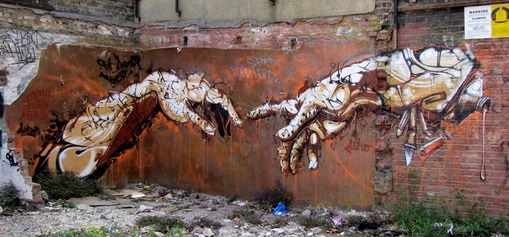"Contemporary Urban Culture" Research Group
GRAFFITI AND STREET ART
IN CULTURAL CITYSCAPE

The Creator Touch. London, Brick Lane. Summer 2011.
Photo by N. Samutina
INTERNATIONAL CONFERENCES & PAPERS
The project aims to study graffiti and street art as multilayered and complex urban phenomena and to develop approaches to their conceptualization. Both graffiti and street art are identified as transient and fluid cultural phenomena constituted by the juxtaposition of the local and global logics. While they are deeply immersed in the life of concrete urban districts, special places, local communities, their representations widely circulate via the Internet, appear in movies, enter the art market.
The special aim of the project is to study graffiti and street art in the local context (in Russian urban environment, especially the Moscow one) and to initiate a comparative research of the street art in the big cities looking for correspondences and differences. Being focused on the changeability and the variety of functions of street art and graffiti in urban landscapes. This project is a constellation of the perspectives developed by Cultural Studies, Urban Sociology and Urban Studies, Cultural Anthropology, Visual Studies, and Contemporary Art Theories. It combines a variety of activities. The main form is our research seminar, which takes place every two weeks. During these meetings we present research papers, analyze works and conceptual directions of different street artists, study history of graffiti and street art, talk with experts, watch and discuss movies, etc.
The project is initiated and realized by the research group affiliated with the Institute for Theoretical and Historical Studies in the Humanities (IGITI), National Research University Higher School of Economics, Moscow, Russia. Senior and post-graduate students participate in the project in the framework of the program “Teachers - Students” supported by HSE Academic Foundation (the research grant № 12-05-0002). The leader of the project is Natalia Samutina.